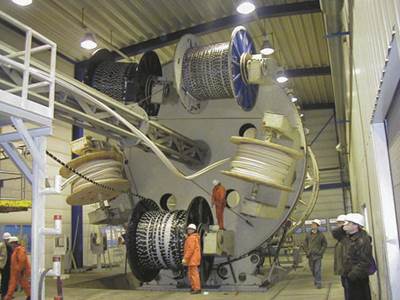Resins
New-Generation Composite Buoyancy Elements Key For Deep Drilling And Production
Principal suppliers of riser buoyancy products include major producer Balmoral (Aberdeen, Scotland, U.K. and Houston, Texas, U.S.A.) and CRP Group Ltd. (Skelmersdale, Lancashire, England, U.K.), which also owns Emerson & Cuming (Canton, Mass., U.S.A.). Balmoral customizes epoxy resins, which are used to cr
Read MoreDesign Issues With Tendons
A composite tendon is essentially a rope made from small-diameter rods, which are pultruded with carbon fiber. Multiple rods are gathered together and twisted slightly to form a strand, using typical wire rope stranding methods. Depending on the performance requirements, 10 to 40 strands, about 2 to 3 inches/5
Read MoreComposite Drill Pipe An Available Option
Lincoln has been producing flexible composite drill pipe for short-radius, horizontal drilling since 1991. Its nominal 2.375 inch /60.3 mm (OD), 30 ft/9m long pipe shaft is filament wound with 12K carbon fiber combined with glass fibers in epoxy resin over an elastomeric liner. Standard API rotary shoulder too
Read MorePetrobras Pioneers Topside Composites
Petrobras (Rio de Janeiro, Brazil) was the first major oil company to experiment with molded gratings in the 1980s, though these early products proved unsatisfactory due to wide variations in mechanical properties. However, advances in pultrusion and filament winding technology coupled with the availability of
Read MoreComposite Tether Goes To Sea
Conoco and KOP have manufactured a prototype of a carbon fiber composite tether that could extend TLP production to depths exceeding 10,000 ft/3,000 m. The design has undergone extensive static testing and fatigue loading and has been verified through hydrodynamic model testing. Sea testing is being planned.
Read MoreIssues With Design
Though steel is the traditional material for coiled tubing because of its low price, it is susceptible to corrosion, fatigue failure (caused by repeated coiling and uncoiling), and troublesome joints. In larger sizes, its weight can increase transport difficulties. With the advent of secondary recovery methods
Read MoreOther Applications Expand
A growing area in the offshore world is the refitting or “recycling” of older oil platforms to support additional production. A particularly active area for recycling is in the North Sea, where additional pipelines can be run to existing rigs for about $1 million (as opposed to spending $20 million for a new r
Read MoreSubsea Wellhead And Pipeline Protection Covers
Wellhead and pipeline protection covers are required under the Norsok regulations for subsea installations in the Norwegian sector (Standard U-002, Subsea Structures and Piping System). Traditional steel wellhead covers are very large — often more than 50 ft/15m square — to allow ROVs access to the Christmas t
Read MoreCustom Wet Layup Repair Solutions
In the second group are customized repairs, employing glass or carbon reinforcement, wet out with vinyl ester, polyester or epoxy resin and applied to the pipe by trained personnel, have been available since the mid-1990s. Selection of reinforcement material, wrap thickness and overlay length is dictated by th
Read MoreComposites Used For Repair by Statoil
Statoil has used composites to repair steel topside components for more than 10 years on the Statfjord and Gullfaks platforms, using wet layup methods designed for each application, says Melve. “We repaired four water lines at an onshore oil storage facility between 1983 and 1987,” he says. “After nine years,
Read More









